Friedrich Engels believed that labor created humans, but modern scientists argue that love, children's curiosity, and long-distance running played a much more significant role in the formation and development of our species. In his lecture series for Qalam, paleontologist Alexander Markov explains how and why Homo sapiens emerged.
The term ‘cultural drive’, in a sense similar to its current meaning, was first used by the prominent American geneticist Allan Wilson (1934–1991). In an article published in the Scientific American in 1985, Wilson suggested that the development of cognitive abilities, including social learning and cultural transmission of behavioral traits, could accelerate biological evolution.
The idea is as follows: animals that are more intelligent and better at learning tend to invent new behaviors more frequently and pass these innovations more effectively to others (for example, younger animals learn from older ones). This creates cultural traditions that shape the behavior of animals, thus establishing new pathways for natural selection. Imagine that certain animals learn to climb trees when they see a predator and that this behavior is preserved within the population as a cultural tradition. If this behavior significantly increases survival, selection will favor individuals who learn this behavior faster and perform it more effectively.
This can lead to improvements in innate learning abilities as well as in the evolution of grasping fingers and claws. Eventually, the behavior might even become instinctual, meaning animals would automatically climb trees upon seeing a predator without needing to learn to do so. However, primates do not possess instincts in the strictest sense, complex, entirely innate sequences of actions triggered by specific stimuli. Among primates, no complex adaptive behavior is formed entirely without learning, based solely on the innate properties of the nervous system.
One way or another, in the hypothetical situation under discussion, a behavioral (cultural) tradition emerges first. Then, by altering the direction and strength of selection, this tradition drives the population to evolve in a new direction.
Thus, culture guides evolution (hence the term ‘cultural drive’).
The more developed an animal’s cognitive abilities (including the ability to learn from others), the more its evolution is likely to depend on culture. This mechanism is sometimes referred to as ‘cultural niche construction’. The term emphasizes that when animals acquire a new cultural tradition, they effectively create a new ecological niche for themselves, with all the respective evolutionary consequences. Natural selection will now adapt them to this new ‘cultural niche’.
For example, if everyone learns how to to wrap themselves in animal skins during cold weather or to butcher large animal carcasses with stone tools so that they can effectively compete for meat resources in the savanna against giant hyenas and other scavengers, this becomes a new ecological niche that the population will now inevitably begin to adapt to under the influence of natural selection. Adaptation to such a cultural niche can have significant evolutionary consequences, from smaller teeth, jaws, and intestines to relaxed energy constraints on brain growth and the loss of body hair.
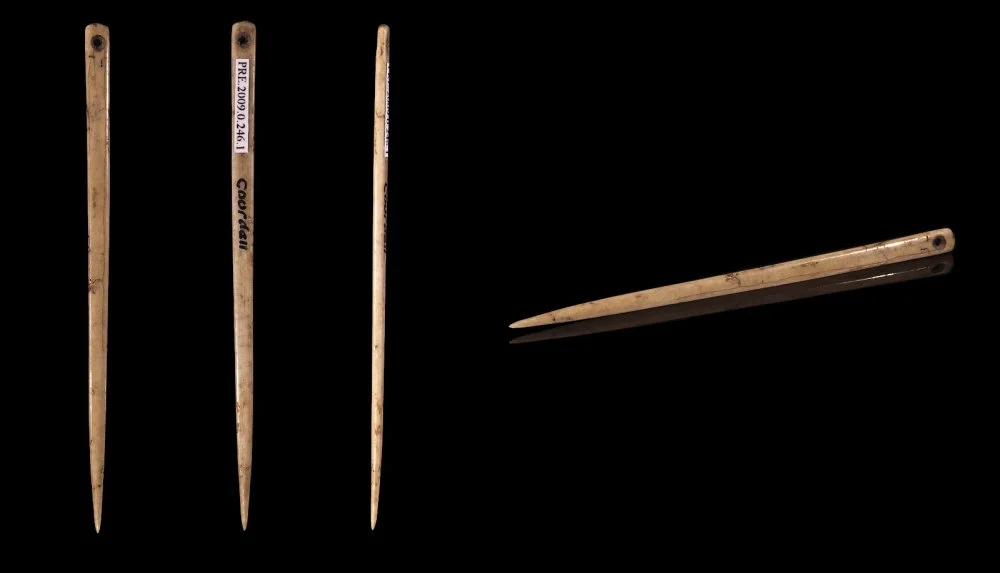
Flat bone sewing needle. Gourdan cave called "Elephant Cave", Gourdan–Polignan, Haute-Garonne , France. Magdalenian Upper Paleolithic (between 17,000 and 10,000 Before the Current Era)/Wikimedia Commons
However, humans likely lost their fur not because of clothing but due to the emergence of permanent settlements, which brought increased problems with parasites. Alternatively, this might also have occurred as part of the adaptation to long-distance running under the scorching sun. In a previous lecture in this series, we already discussed how some hunter-gatherers still practiced endurance hunting, or pursuing zebras, deer, or antelope until the swift-footed prey collapsed from exhaustion. What’s important to recognize now is that clothing, permanent settlements, and endurance hunting are all cultural traditions that form a cultural niche. These adaptations are ‘encoded’ in culture and not in the genes. However, the absence of fur and the extraordinary development of sweat glands in humans are true biological adaptations, meaning they are genetically determined. Yet, these are adaptations to a cultural niche shaped by natural selection, which was directed by culture.
How We Learned to Drink Milk
A classic example of gene-culture coevolution (the interconnected evolution of genes and culture) is the spread of mutations that allow adults to digest milk sugar or lactose. These mutations became widespread after the emergence of dairy farming among inhabitants of certain regions in Europe, Africa, and the Middle East. All typical mammals (except for humans who adopted dairy farming) drink milk only in early childhood. As they transition to independent feeding, the enzyme lactase, which breaks down lactose, is no longer required, and its production ceases. After this, they struggle to digest milk, though this is not an issue because adult mammals do not drink milk. However, it became a problem for humans when they began milking domesticated animals, such as goats, sheep, cows, and mares. In these populations, natural selection began to favor mutant variants of certain regulatory regions of DNA. People with such mutations produce the enzyme lactase throughout their lives, allowing them to drink milk as adults without digestive issues.
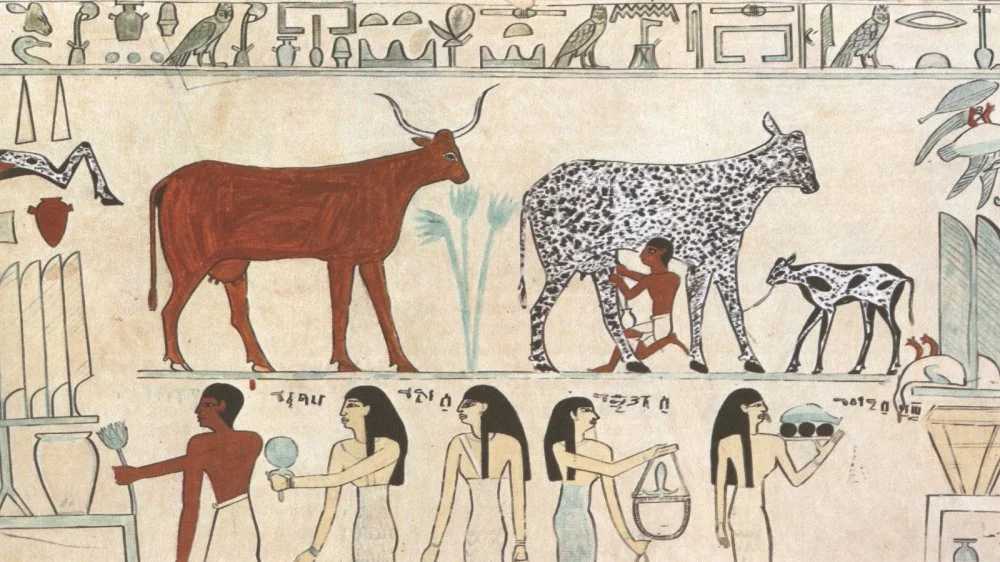
Egyptian Domesticated Animals/Wikimedia commons
Interestingly, the evolution of lactose tolerance occurred independently in different populations: African, European, and Middle Eastern pastoralists developed different mutations with the same effect. On the other hand, the nomadic herders of Central and East Asia appear to have adapted to a dairy diet not genetically but purely culturally—through the consumption of fermented dairy products, which contain little lactose. Lactose tolerance alleles (genetic variants) did not spread among them.
Recently, paleogeneticists analyzed the genomes of Europeans from the Bronze Age and early medieval periods. It turned out that 3,000–4,000 years ago, lactose tolerance in Western Europe was still a rare trait that spread rapidly in subsequent eras. This data indicates robust selection in favor of the lactose tolerance allele, which has been active in Europe over the past three millennia.

Johannes Vermeer. The Milkmaid. 1658-1660/Wikimedia Commons
In this case, a cultural innovation (animal husbandry combined with the practice of drinking raw milk) provided individuals whose lactase enzyme production continued beyond the breastfeeding period a selective advantage. What exactly accounted for this selective advantage? Well, several hypotheses exist. The most obvious consideration is that milk is a highly nutritious product, and in ancient times, people rarely suffered from an excess of calories. However, if one consumes fermented milk products like yogurt or cheese instead of milk, the problem of lactose intolerance is largely resolved. Milk may have also helped address calcium deficiencies in people whose diets were lacking in vitamin D and who lived in higher latitudes, where there is little sunlight and, consequently, fewer opportunities to produce this vitamin via ultraviolet radiation. Additionally, there is evidence that consuming milk can alter gut microbiota composition, reduce the risk of diarrhea during times of famine, and even mitigate malaria symptoms. Finally, drinking milk may have been beneficial simply because it was a relatively pathogen-free drink, unlike the often contaminated water people had to drink in the past.
Yams and Malaria
Another well-studied example of gene-culture coevolution is the spread of the sickle cell anemia allele among West African farmers who cultivate yams. If a person has two copies of this allele, inherited from both parents, they suffer from severe anemia, which is harmful. However, if they have only one copy, their anemia is less severe, and they gain protection from malaria, which is rampant in that region. The yam cultivation techniques used by these farmers involve clearing forests, which leads to the land becoming swampy and a sharp increase in the population of mosquitoes carrying malaria.
Under these conditions, natural selection favors the sickle cell anemia allele as protection from malaria outweighs the harm caused by anemia. As a result, yam-growing farming tribes are less affected by malaria than their neighbors. This may have given them an advantage in intergroup competition: when they cleared another section of forest to grow yams (and, incidentally, increase the mosquito population), neighboring tribes living in uncleared areas began to suffer from malaria. This helped the farmers displace them and take over new lands. In this case, the cultural tradition (yam cultivation) evolved alongside a genetic trait—malaria resistance. There may also have been a feedback loop at play, as yams, according to some data, may help alleviate the symptoms of sickle cell anemia.

A man harvest Yams on his farm in Nandom/Alamy
How Cultural Drive Works
Allan Wilson emphasized not only the guiding influences of culture on biological evolution but also its accelerating effects. The idea of cultural drive was further developed by British evolutionary biologist Kevin Lala and other researchers, who reinterpreted it by focusing on the concept that the coevolution of social learning, cognitive abilities, and culture can be autocatalytic—that is, self-sustaining. To clarify, social learning refers to the acquisition of knowledge, skills, and behaviors, not through personal experience, one's own intellect, or trial and error but by borrowing from others, such as through imitation.
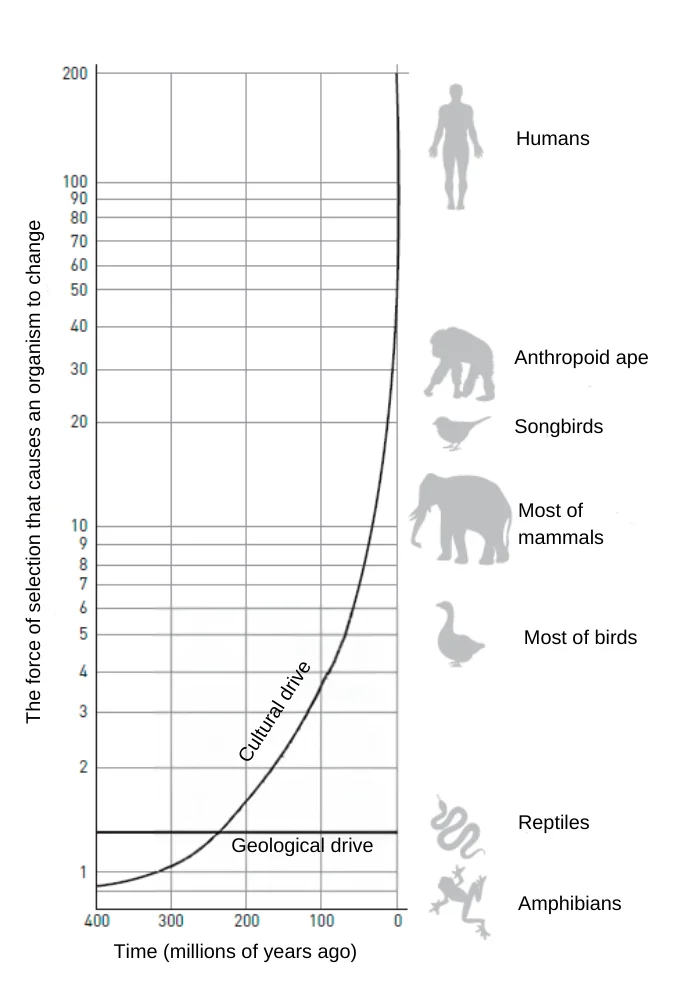
The influence of cultural drive on evolution/Alexander Markov
In its simplest form, the proposed mechanism of positive feedback looks like this:
Evolution of social learning abilities → Behavioral innovations are more likely to be preserved as cultural traditions, enriching culture → Individuals can now learn a greater number of valuable skills from their peers, making social learning more advantageous; more complex and flexible behaviors present new cognitive challenges → Selection favors even more effective social learning and cognitive abilities → An even richer culture, and so on.

The influence of cultural drive on evolution/Alexander Markov
The diagram can be expanded by adding a few more positive feedback loops.
One of these is based on increased lifespan. The development of culture can make life more secure. For example, the invention of new ways to obtain food reduces the risk of starvation during environmental fluctuations (such as drought), and the knowledge of medicinal herbs and roots can decrease mortality from illness. As a result, the average lifespan increases, and a longer life makes individuals more effective at preserving and passing on valuable knowledge and skills as shown below:
Selection for social learning abilities → Advanced culture → Increased survival → Longer average lifespan → Improved ability to retain and transmit knowledge → Even more advanced culture → Intensified selection for social learning abilities, and so on.
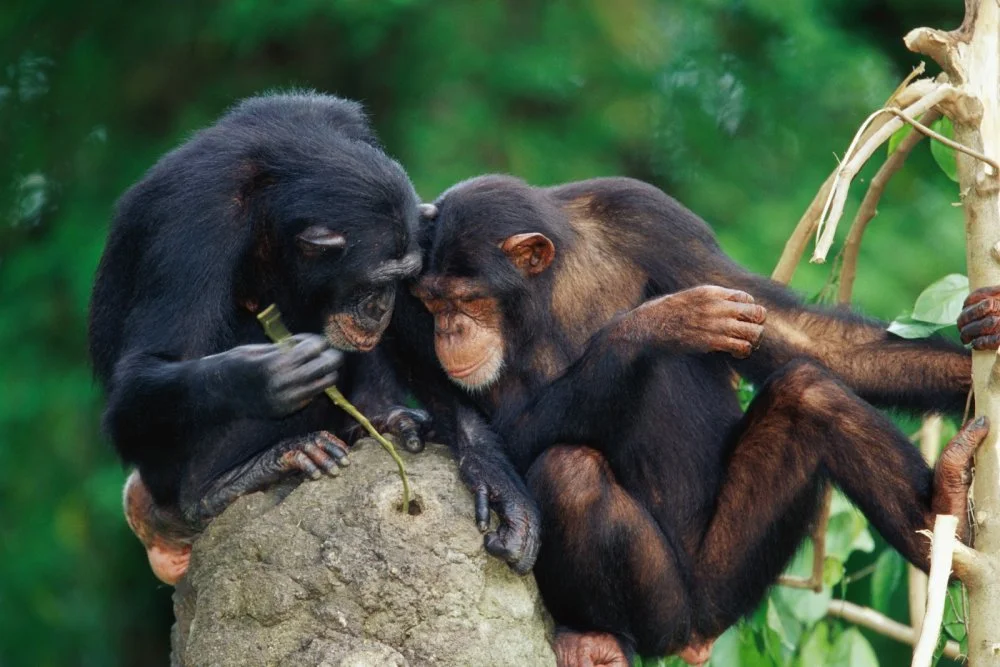
Chimpanzees learning to catch termites/Getty Images
Additionally, culture creates conditions for selection for longevity (slower aging) if the bearers of valuable knowledge contribute to the survival of the group and the successful reproduction of its members. For example, in the context of intergroup competition, groups with at least one old, wise individual who helps the group survive in difficult situations through their knowledge may gain an advantage. Or, for instance, if accumulated life experience significantly enhances the effectiveness of caring for offspring that need guidance. Our ancestors were likely subject to strong selection for longevity as evidenced by the fact that the maximum human lifespan is about 120 years, while our closest relatives (chimpanzees, gorillas, and orangutans) rarely live past 60, even in ideal conditions with excellent medical care, and in the wild, they usually don't reach 50.
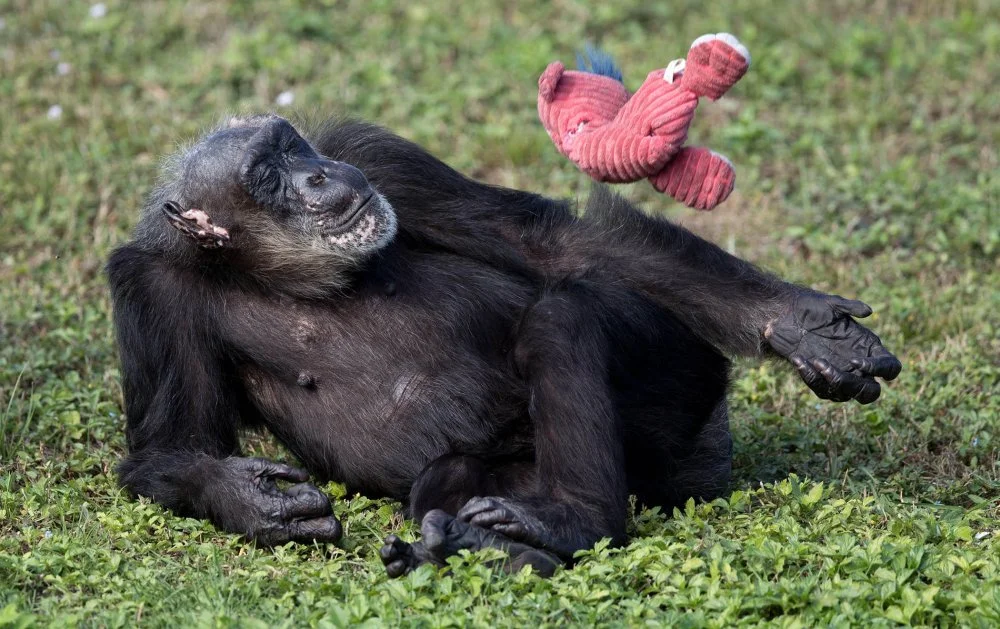
Little Mama, the oldest known chimpanzee (1937 (?) — 2017),, ( Dr. Jane Goodall estimates her age to be around 78-years-old) playing with a toy. Lion Country Safari in Loxahatchee, Florida, December 22, 2016/Allen Eyestone/The Palm Beach Post/ZUMA Wire/Alamy Live News
The emergence of a long post-reproductive period in females (menopause), seen in humans and some cetaceans (marine mammals of the order Cetacea; whales, dolphins, and porpoises), for whom culture also plays a crucial role, may be linked to culture. The evolution of menopause is presumably due to the decreasing evolutionary advantage of bearing children as females age (it becomes harder to carry, feed, and raise a child, and there is a higher risk of not completing this task). Thus, natural selection might favor the cessation of female reproductive function at a certain age, after which, for example, the individual can dedicate herself to caring for grandchildren. In males, according to this theory, there is no menopause because a father's health is less critical to the survival of offspring (in mammals, even those forming stable mating pairs, the primary responsibility for caring for offspring lies with the females).
Intelligence, Food, and Sex
Another positive feedback loop could have been provided by an improved diet:
Advanced culture, which includes efficient ways of obtaining valuable food resources → Better nutrition → Reduced energy constraints on brain development.
For instance, the increase in brain size in early Homo erectus is traditionally linked to a higher intake of meat. There is direct archeological evidence that meat played a significant role in the diet of Homo erectus. For example, in Kenya, the bones of an adult female Homo erectus were found with pathological bone growths characteristic of hypervitaminosis A, a condition caused by consuming too much animal fat. Whether Homo erectus were skilled hunters or scavengers is still debated, but the fact remains that they brought animal carcasses or parts of them to their camps and scraped the bones with stone tools.
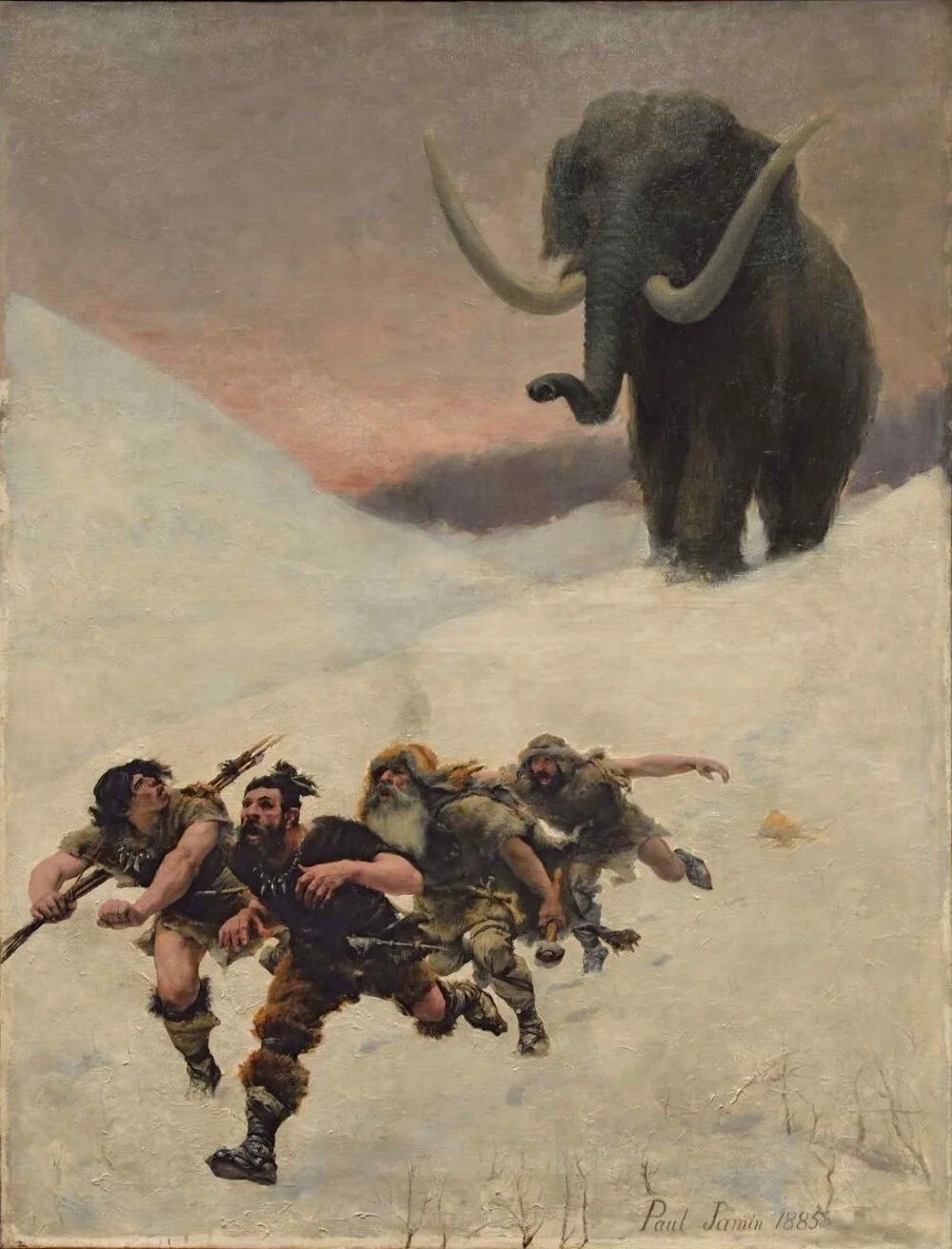
The Flight before the mammoth/Fine Art Images/Heritage Images/Getty Images
But was it just the meat? In 1999, anthropologist Richard Wrangham and his colleagues proposed the hypothesis that early Homo erectus, who appeared about two million years ago, already knew how to cook food over fire, which drastically reduced the energy required by the body to digest it. This hypothesis leads to several interesting implications: the division of labor between genders (men hunting, women cooking), the rise in the social status of the female provider, which can be linked to the presumed reduction in sexual dimorphism in Homo erectus compared to Homo habilis, and even the formation of an associative link between food and sex.
Wrangham's hypothesis was based on indirect evidence, such as the fact that early Homo erectus not only had larger brains but also larger bodies. Additionally, their teeth became smaller, indicating that they no longer needed to chew as much.
For comparison, chimpanzees spend an average of five hours a day chewing, while modern hunter-gatherers who cook their food over fire spend only about one hour in the same activity.
In subsequent years, Wrangham and his colleagues conducted a series of experiments to support this idea. They fed different animals (such as mice and Burmese pythons) raw and cooked meat. Pythons spent 12.7 per cent less energy digesting cooked meat, and when the meat was ground as well, the energy conserved reached 23.4 per cent. An energy gain of this magnitude significantly enhances an animal’s competitiveness and would likely be favored by natural selection.
Groups of ancient humans who learned to cook food likely reproduced faster than their backward, raw diet-eating counterparts. Mice fed cooked meat gained 29 per cent more weight over five weeks compared to identical mice that were fed raw meat (with the same caloric intake). This suggests that a change in diet among ancient humans could have almost immediately impacted their body size even without any evolutionary changes.
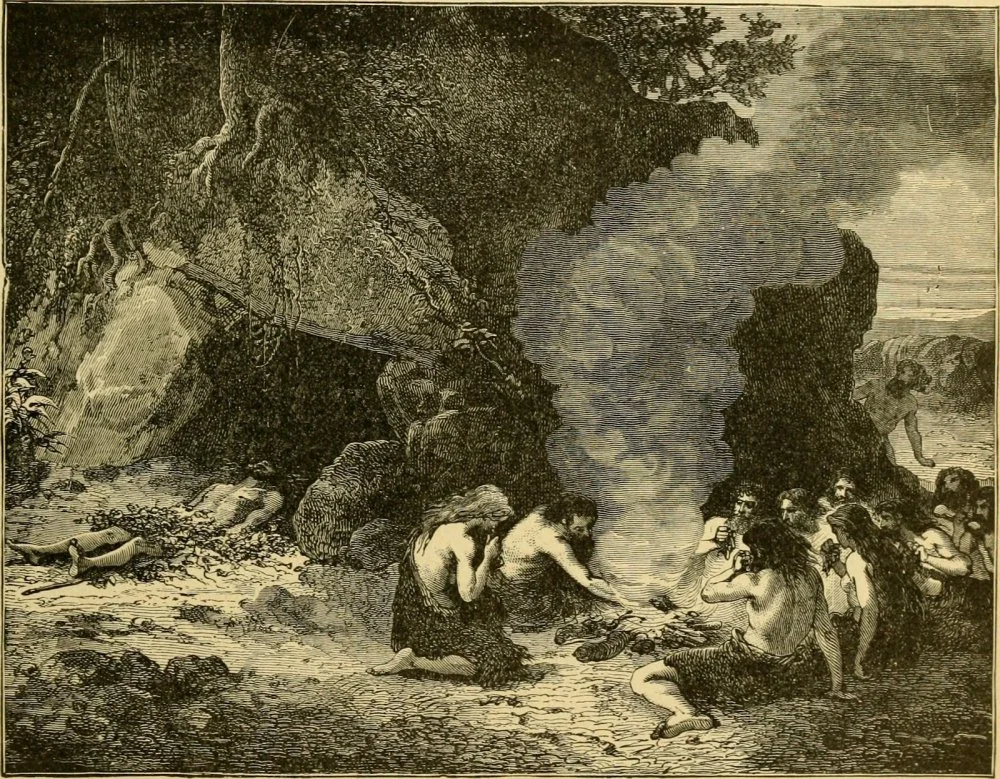
Ridpath's history of the world. 1897/Wikimedia Commons
The hypothesis seems logical, but there's one problem: any direct evidence of fire use by early Homo erectus has not yet been discovered. The oldest completely indisputable hearth (with charred stones, seeds, and wood) was discovered in Israel and dates back 790,000 years. Recently, in southern Africa, nearly definitive evidence of control over fire was found dating to around 1 million years ago. There are also earlier traces of fire use, but researchers have not been able to conclusively prove that the fire that left its marks on stones and bones was controlled by humans. Some experts allow for the possibility that these could be the traces of natural wildfires.

A hearth (at top of photo) discovered in Qesem Cave shows multiple layers of ash laid down over time/Photo by Ran Barkai, Department of Archeology, Tel-Aviv University/nationalgeographic.com
The gradual shift to increasingly easily digestible food not only reduced energy costs for chewing and digestion but also laid the groundwork for a reduction in the size of the digestive system, which also resulted in significant energy savings. Among primates, an inverse correlation has been found between brain size and the digestive system. Smarter primates, as it turns out, consume more high-calorie foods (insects, bird eggs, et cetera) and have smaller digestive systems. Species with smaller brains tend to consume readily available but less nutritious food (leaves, fruits), and their digestive tracts are longer.
The Cultural Drive—For Intelligence
The cultural drive hypothesis has already received some indirect empirical support. For example, among primates, positive correlations have been found between the following indicators:
-
The development of social learning (which can be assessed by the number of observed successful transmissions of skills from one individual to another with necessary adjustments for research effort, that is, the total observation time for individuals of a given species);
-
Brain size (whether absolute or relative: similar correlations are observed in both cases);
-
Lifespan and length of childhood (the period of most active learning); and
-
Size of social groups.
Similar correlations have also been found among cetaceans. It’s important to recognize that the cultural drive hypothesis does not conflict with other theories, such as the social brain, Machiavellian intelligence, the brain's role in intra-group cooperation, stone tool production, or attracting sexual partners.
The idea of cultural drive can encompass a wide range of such specific hypotheses. The fact is that the self-sustaining coevolution of the brain and culture can be based on a variety of culturally inherited knowledge, skills, and behaviors. It is not rigidly tied to any one type of skill. Potentially, almost any knowledge could be suitable here! But it is not simply any knowledge we are talking about—it must meet at least two conditions.
First, this knowledge should not be too simple. If just about anyone can learn the skill, the spread of that skill in a cultural environment will not create selection pressure for the improvement of intellectual abilities. It goes without saying that the knowledge shouldn't be excessively complex either. If a particular behavioral innovation is only accessible to geniuses born once every hundred years, it will never become a cultural tradition. It will almost certainly die with the genius who invented it.
Second, this knowledge must provide reproductive advantages to its holders. In other words, it must increase fitness, be useful (or advantageous) in the sense that evolutionary biologists use these words. Only useful (fitness-enhancing) knowledge, when spread in a cultural environment, will promote the spread of the genes of those individuals who have best mastered it—these will be the genes of the diligent and clever learners. The essence of the cultural drive hypothesis lies in the spread of the genes of good learners.
If an individual lacks the ability to acquire knowledge, they will find no place in a new cultural environment—they will not learn how to behave according to the new traditions, or they will have to invent everything anew on their own. Therefore, the ignorant will not leave behind many offspring. The more capable a student is, the more useful knowledge they will master, the more offspring carrying their genes of successful learning they will leave behind, and the better their children will be at mastering the cultural traditions of their society, including new ones that may arise. As a result, the cultural wealth of society will grow, making social learning abilities even more valuable and important.

The life of the cave dwellers. 19th century illustration/Getty Images
Thus, there are certain criteria for complexity and usefulness when it comes to the skills on which cultural drive is based. However, these skills and knowledge can be almost anything as long as they contribute to cultural evolution and are passed down through learning and social interaction. They can include hunting techniques, stone tool-making technologies, social skills for interacting with peers and making a good impression, methods to attract sexual partners, the knowledge of medicinal herbs, the ability to distinguish a venomous snake from a harmless one, the capability to organize coordinated collective actions when confronting a hostile group, et cetera. The question of how different categories of useful knowledge affect the efficiency of cultural drive, how this influence manifests, and what factors determine it all deserves dedicated research.
The Cognitive Explosion
The remarkable universality and flexibility of the cultural drive hypothesis were vividly demonstrated using a computer model developed in 2006 by evolutionary biologists Sergey Gavrilets and Aaron Vose. Their model works as follows: males in the model population compete for females. The population practices promiscuity and polygyny (that is, indiscriminate sexual relationships), the male contribution to offspring is minimal, and as a result, the male reproductive resource is abundant while the female one is in sharp deficit. As expected in such a situation, a male's reproductive success depends directly on the number of females he can mate with, which, in turn, is determined by the outcome of the competition between males, a competition that depends on male behavior. This is where culture comes into play. Occasionally, males randomly invent memes, or behavioral strategies or tricks that increase their chances of winning in the competition for females. These inventions occur very rarely, but there is another way to acquire a useful meme: one male can learn it from another through social learning, by observing and memorizing it for instance.
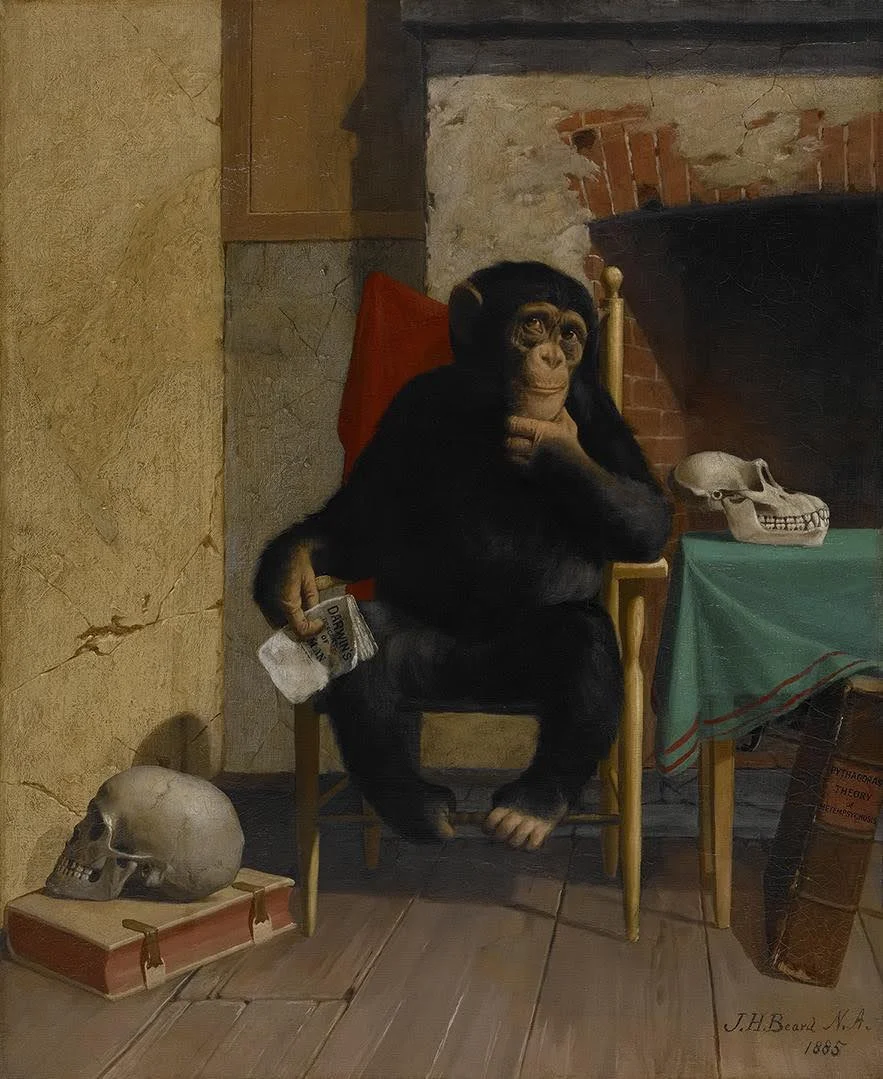
James Henry Beard. "It Is Very Queer, Isn't It?" . 1885/Wikimedia Commons
Sooner or later, a self-sustaining process resembling a chain reaction inevitably begins, a process that the authors have called a cognitive explosion. It starts when someone eventually invents a useful but relatively simple meme that can be remembered, though not by everyone—only by the most ‘brainy’ individuals in the population. The individuals who learn this meme gain a selective advantage, meaning they produce more offspring to whom they pass on their genes for strong memory and learning abilities. From the moment the first useful meme is fixed in a culture, the natural selection for better social learning abilities (memory and learning) begins. Improvement in these abilities leads to more frequent emergence and retention of new useful memes.
This process leads to a synergistic and accelerating increase in cognitive capabilities, cultural complexity (measured by the diversity of memes within a society), and the Machiavellian fitness of individuals. The cognitive explosion is based on the mechanism of cultural drive: as the number of memes (ideas and practices) in a society grows, there's an increasing evolutionary advantage for individuals who can effectively remember, learn, and apply this cultural knowledge.
Further development of this research direction (computer modeling of the co-evolution of social learning, culture, and the brain) provides interesting results that help explain why the early representatives of the genus Homo (but not other apes) found themselves, at some point, in a situation favorable for an unprecedentedly powerful cultural drive.
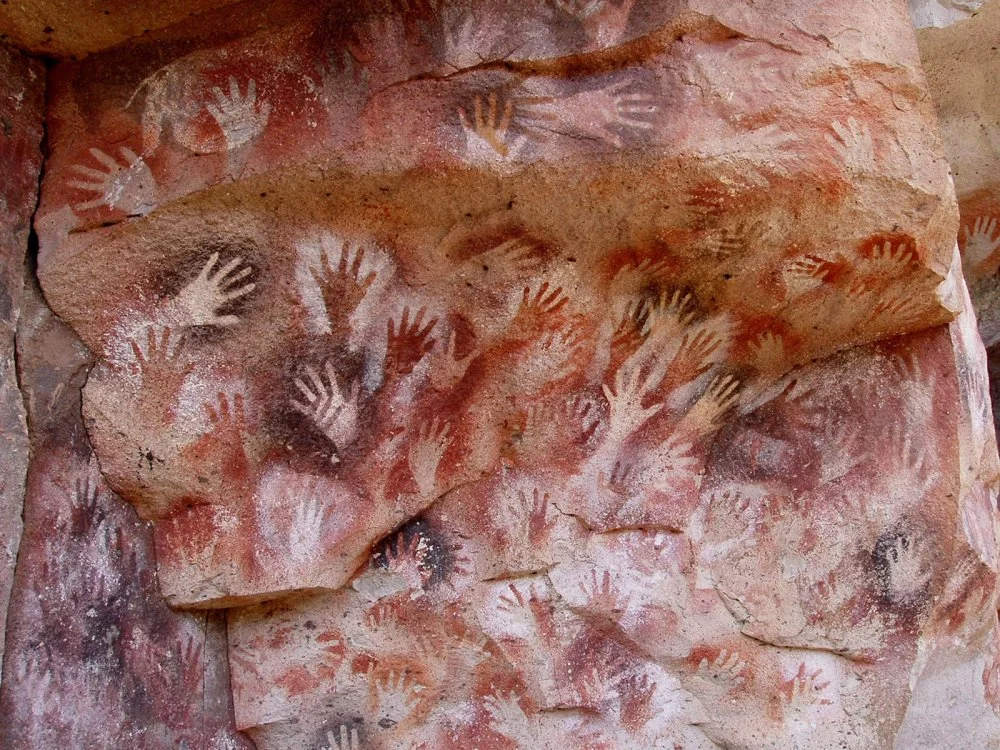
Hands, stenciled at the Cave of the Hands/Wikimedia commons
This occurred due to a change in social and ecological niches. The shift in the social niche was associated with a reduction in intragroup aggression and competition, an increase in parental (including paternal) investment in offspring, and an evolutionary shift towards monogamy, peaceful coexistence, and cooperation with fellow group members. This likely led to a change in optimal strategies to increase social status and reproductive success. Individuals now had to rely less on brute force and aggression and more on Machiavellian intelligence.
The change in the ecological niche was linked to new methods of obtaining food, such as aggressive scavenging (in intense competition with the giant hyenas and other scavengers and predators of the Pleistocene African savanna) and collective hunting of large animals. This required a high level of intragroup cooperation and complex behaviors (demanding advanced cognitive abilities) such as making stone tools.
It is highly likely that the making of primitive stone tools associated with the Oldowan culture, which spread among early Homo, was the first complex and highly useful set of memes. The establishment of these memes in culture may have triggered the powerful cultural drive among our ancestors.
Why Brain Growth Stopped
Modeling results for brain growth offers a possible explanation for one of the most intriguing mysteries of human evolution: why the brain of our ancestors grew rapidly while culture developed at a slow pace (in the early Paleolithic period) but stopped growing and even began to shrink slightly as cultural progress accelerated (in the Middle and Late Paleolithic periods). In computer models, brain growth is well stimulated by a crude, primitive culture consisting of a few large (difficult-to-learn) memes. Later, as culture becomes more sophisticated (filled with many simple memes), brain growth slows down and even reverses. The mechanism behind this scenario can be called the ‘vicious cycle of meme simplification’.
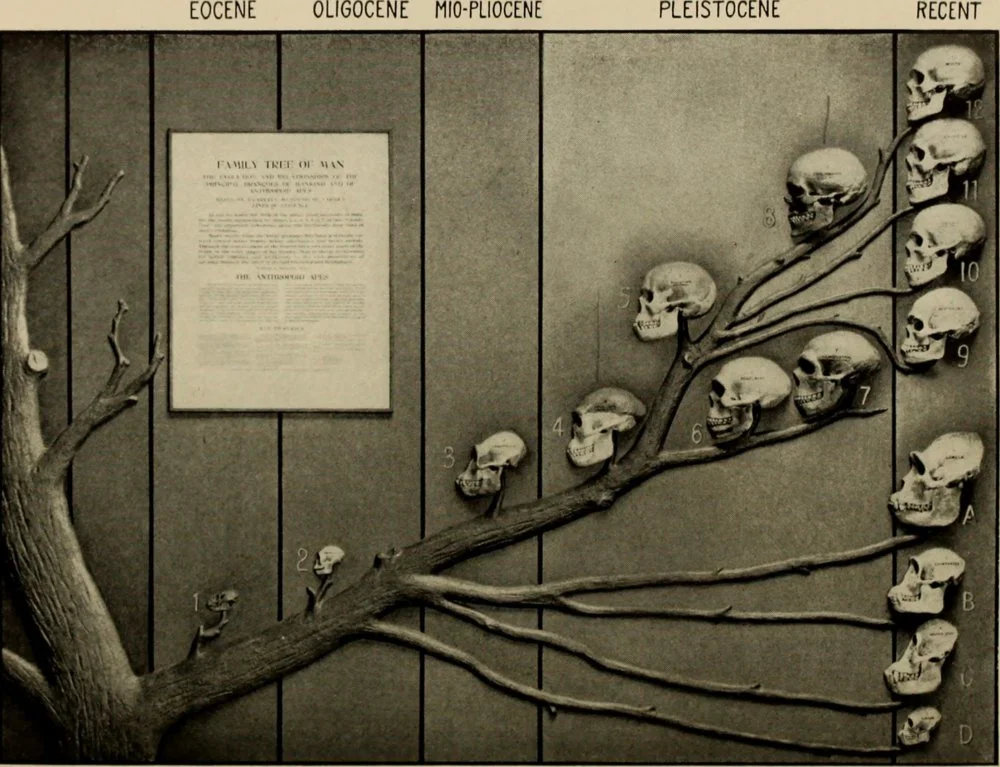
Human Evolution Tree. Beginning of the 20th century/Wikimedia Commons
It can also be hypothesized that the extraordinarily rapid brain growth seen during human evolution, which eventually unlocked unique (and, of course, unforeseen) opportunities for the development of civilization, was a kind of ‘evolutionary accident’. The cultural drive was simply too strong to allow the brain to evolve in a more balanced way, such as through structural reorganization and the fine-tuning of neural networks for specific cognitive functions. Such fine evolutionary work requires more time, and selection must be more gentle. In reality, however, selection was so strong that it favored alleles that improved cognitive functions at almost any cost, which is how we ended up with a brain of such an enormous size.
Cultural drive is exactly the kind of mechanism that could create powerful ongoing selection for enhanced cognitive abilities.
Additional amplifiers of the coupled evolution of the brain and culture could have been positive feedback loops passing through population growth (as cultural adaptations arise more frequently and are less likely to be forgotten in a large population) and through increased lifespan. Both effects could occur, for example, if cultural development led to a decrease in mortality, which most likely did actually occur. This has long been hypothesized, and the modeling supports it.
Finally, the modeling showed that without intense intergroup competition, it is difficult to develop a large brain and even harder to develop a culture that isn't cluttered with parasitic memes. Cultural group selection, driven by strong competition between groups, effectively manages the contents of the meme pool, promoting the spread of socially beneficial memes and curbing the spread of parasitic or individually advantageous ones. Incidentally, Darwin, though in different words, also wrote that we owe our moral qualities to intergroup competition and cultural group selection.
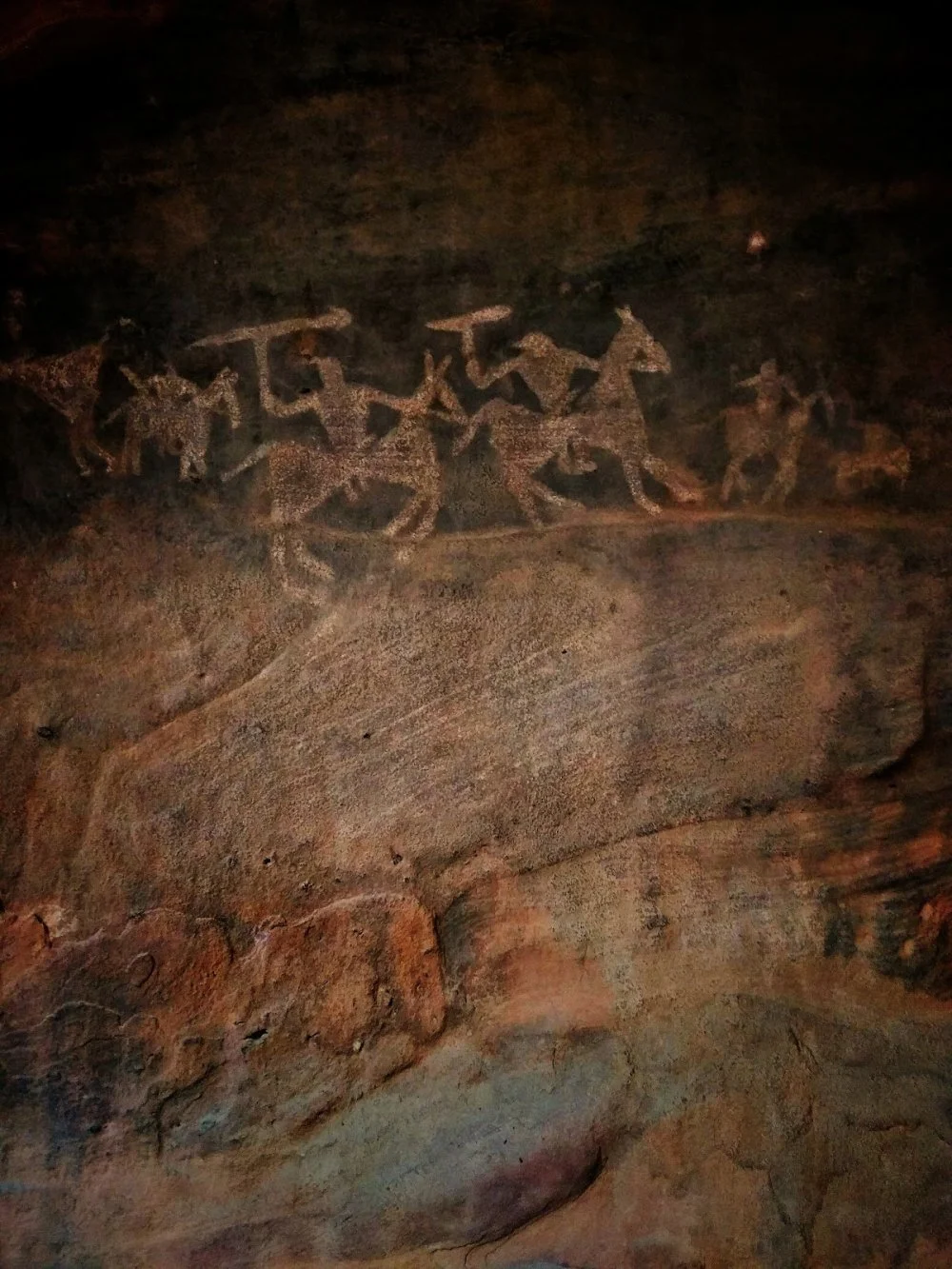
The rock paintings about 100000 years old in Bhimbetka, Madhya Pradesh /Wikimedia Commons
Conclusion
In concluding our discussion on the coevolution of the brain and culture, it’s important to highlight a key idea: cultural evolution can be almost as blind a process as biological evolution. No one consciously designed our hands, capable of the finest manipulations, our hairless skin with numerous sweat glands, or our feet, perfectly adapted for walking upright. These were shaped by blind natural forces, specifically, random (undirected) hereditary variation and natural selection, which, as we now know, were heavily influenced by culture.
Similarly, most likely, no one consciously designed (and certainly no one could have invented from scratch) the Acheulean hand ax (the preferred tool of Homo erectus), bone sewing needles, or even the Inuit kayak (although certain subtleties in the construction of these items could, of course, have been consciously developed).
Even modern hunter-gatherer communities often cannot explain why they behave in certain ways—‘This is our custom’ is their typical response to anthropologists' inquiries. But cultural evolution is smarter than we are. It doesn't require understanding causes and effects: blind processes, such as random behavioral variation (made hereditary through social learning) and selection at two levels (the individual and group), are sufficient. Cultural selection at the individual level in real human (and even primate) societies can be quite effective as individuals tend to learn more eagerly from successful and authoritative members of the community than from failures. Group-level cultural selection works because societies with more successful cultures grow, multiply, and outcompete rivals, who sometimes deliberately borrow cultural elements from their more successful neighbors, often without understanding the actual beneficial function of these elements. Consider Peter the Great's reforms—shaving beards and wearing wigs probably did little to boost the economic or military power of the Russian Empire, but the tsar borrowed these customs from Europeans just in case.
Biological evolution gave rise to cultural evolution and merged with it into a single, complex process that led the Homo genus down a previously unknown evolutionary path. Only time will tell where this path will take us—to the colonization of the galaxy, to a peaceful halt in development, to equilibrium with nature and stagnation, or to self-destruction.

Lower Palaeolithic Handaxe/Wikimedia Commons
